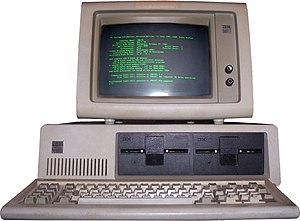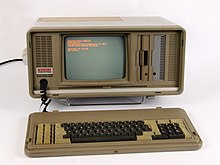Monochrome monitor
This article needs additional citations for verification. (August 2010) |


A monochrome monitor is a type of computer monitor in which computer text and images are displayed in varying tones of only one color, as opposed to a color monitor that can display text and images in multiple colors. They were very common in the early days of computing, from the 1960s through the 1980s, before color monitors became widely commercially available. They are still widely used in applications such as computerized cash register systems, owing to the age of many registers. Green screen was the common name for a monochrome monitor using a green "P1" phosphor screen;[1] the term is often misused to refer to any block mode display terminal, regardless of color, e.g., IBM 3279, 3290.
Abundant in the early-to-mid-1980s, they succeeded Teletype terminals and preceded color CRTs and later LCDs as the predominant visual output device for computers.
CRT Design

The most common technology for monochrome monitors was the CRT, although, e.g., plasma displays, were also used. Unlike color monitors, which display text and graphics in multiple colors through the use of alternating-intensity red, green, and blue
Typically, only a limited set of brightness levels was provided to save
Monochrome monitors are commonly available in three colors: if the P1 phosphor is used, the screen is green monochrome. If the P3 phosphor is used, the screen is amber monochrome. If the P4 phosphor is used, the screen is white monochrome (known as "page white"); this is the same phosphor as used in early television sets.[2] An amber screen was claimed to give improved ergonomics, specifically by reducing eye strain; this claim appears to have little scientific basis.[3]
Usage
Well-known examples of early monochrome monitors are the
The 5151 was designed to work with the PC's
Clarity
Pixel for pixel, monochrome
Some green screen displays were furnished with a particularly full/intense phosphor coating, making the characters very clear and sharply defined (thus easy to read) but generating an afterglow-effect (sometimes called a "ghost image") when the text
Phosphor limitations
Monochrome monitors are particularly susceptible to
Another effect of the high-intensity
This ghosting effect is deliberate on some monitors, known as "long persistence" monitors. These use the relatively long decay period of the phosphor glow to reduce flickering and eye strain.
In popular culture
The colour scheme, grid layout of characters, and ghosting effects of the now-obsolete monochrome CRT screens have become an eye-catching visual shorthand for computer-generated text, frequently in "futuristic" settings. The opening titles of the first
A similar grid of amber text is used in the science fiction TV show Travelers.
A free application for Linux terminal software called "Cool Retro Term" is available to accurately emulate old CRT Monochrome terminals for nostalgia or
